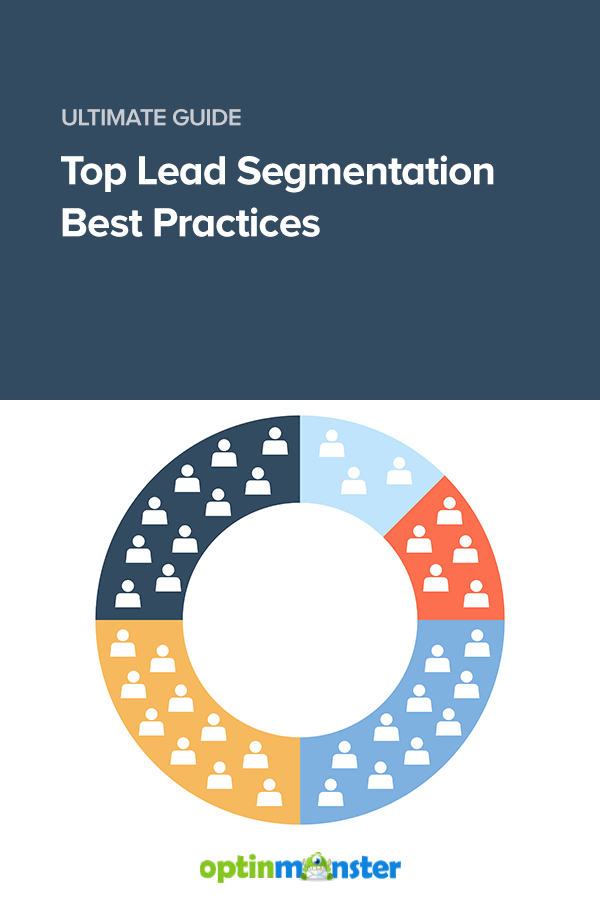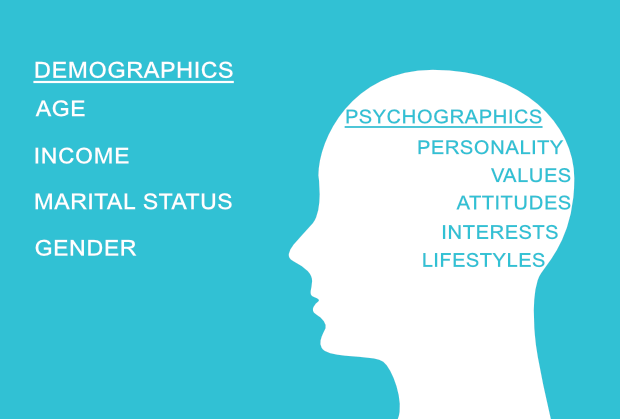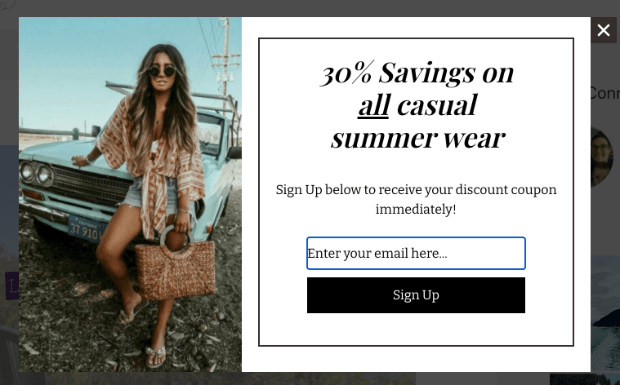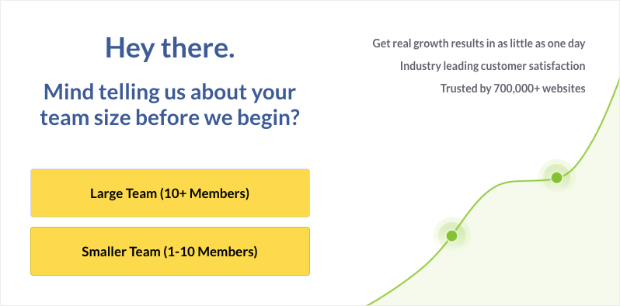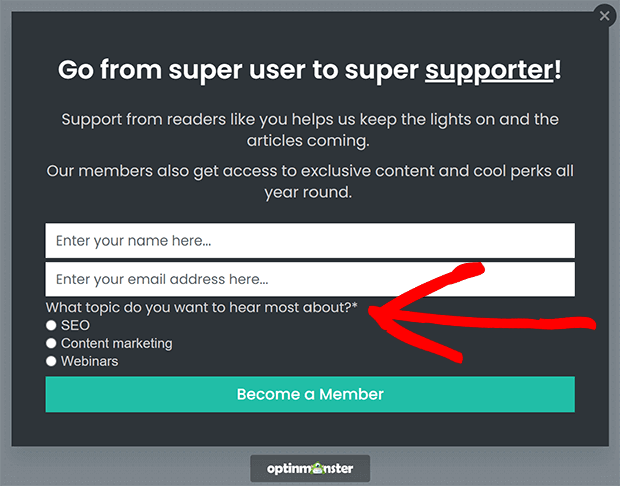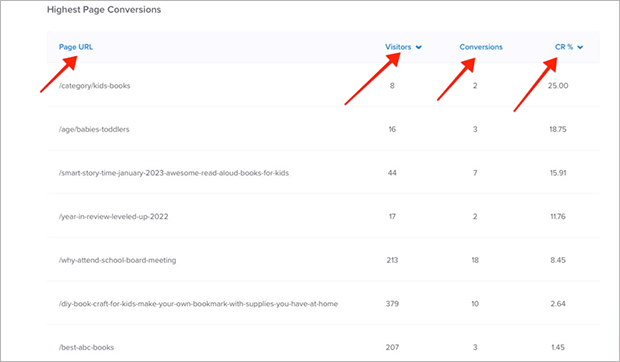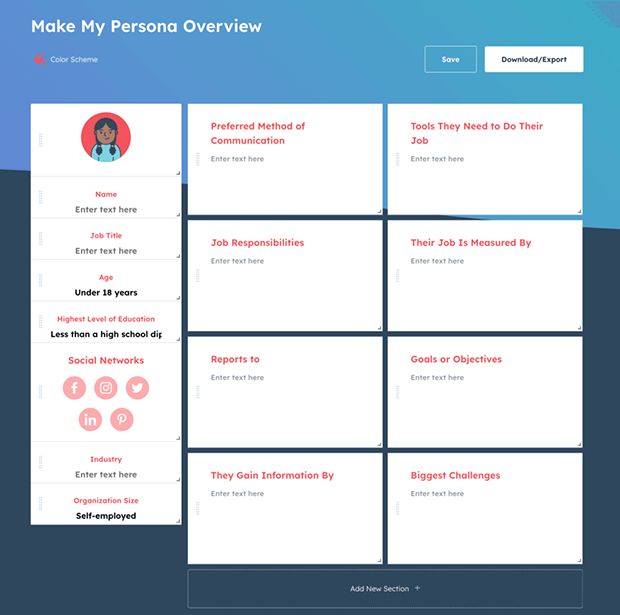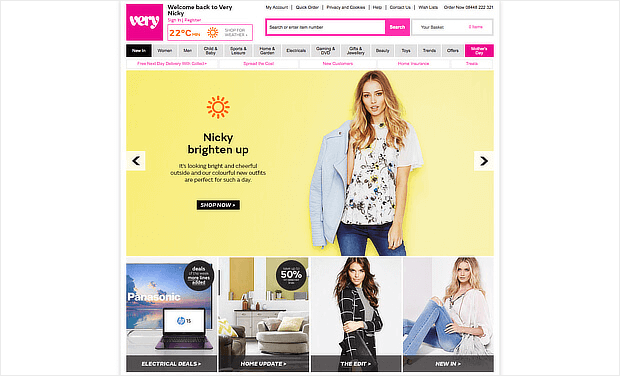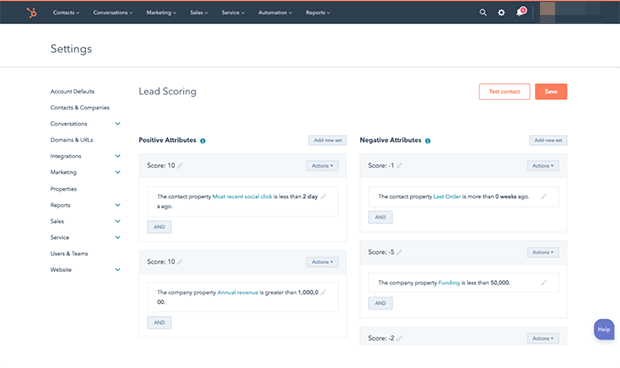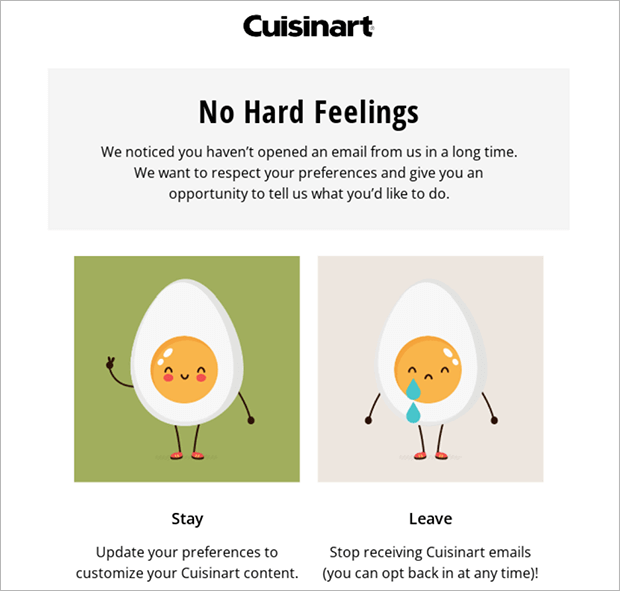Are you looking for lead segmentation best practices to make your marketing campaigns more effective?
Lead segmentation is an effective way to improve your conversion rates. By dividing your leads into specific segments and sending them targeted messaging, you can speak directly to their needs. This makes them more likely to convert.
In this article, we’ll go over some of the basics of lead segmentation and some best practices to help you get started right.
Here is a list of topics we’ll cover in this guide.
- What is Lead Segmentation?
- Types of Lead Segmentation
- Benefits of Lead Segmentation
- Lead Segmentation Best Practices
- Conclusion: Creating a Strong Lead Segmentation Strategy
What is Lead Segmentation?
Lead segmentation is the practice of dividing your leads into groups based on a variety of factors. The goal of lead segmentation is to increase the chances of a lead becoming a paying customer.
Lead segmentation is like organizing a bunch of different toys into separate groups based on what they do or what they look like.
For example, you might group all the toys that are for babies together and all the toys that are for older kids in another group. Or you might group all the toys that are related to cars in one group, and all the toys that are related to animals in another group.
When businesses use lead segmentation, they’re doing something similar with their customers. They’re organizing their customers into separate groups based on things like their age, where they live, what they like to buy, or how they interact with the business.
By doing this, businesses can create specific marketing messages and experiences that are more likely to appeal to each group of customers. It helps them understand their customers better and offer them products or services that they are more interested in.
Now let’s look at some different ways to segment your leads.
Types of Lead Segmentation
There’s no one right or wrong way of segmentation. Most businesses use a variety of factors to create their segments. Here are some different types of lead segmentation:
Demographic Segmentation
Demographic segmentation is based on factors related to human populations. These might include age, gender, nationality, marital or family status, and more.
For example, a company selling baby products might use demographic segmentation to target expectant or new parents. They would then market to this segment with messaging about preparing for their new baby.
On the other hand, a luxury car manufacturer wouldn’t necessarily market to the same demographic. Instead, they might target high-income individuals with ads that emphasize exclusivity and luxury.
Geographic Segmentation
Geographic segmentation is based on where people live. This can include factors such as weather, regional holidays, or language.
One simple example of geographic segmentation is using different languages for audiences in different countries or regions.
Another way to use geographic location to segment your target customers is to think about climate. A clothing company might promote sunglasses and hats to customers in warmer regions, and advertise hats and gloves to customers in colder areas.
Psychographic Segmentation
Psychographic segmentation divides customers into groups based on personality traits, values, attitudes, interests, and other psychological characteristics.
Let’s say a company sells organic and eco-friendly home cleaning products. They might segment their customers based on their attitudes and values towards the environment and health.
Some customers might prioritize reducing their carbon footprint and living a more sustainable lifestyle. Others may be most interested in natural and non-toxic cleaning products that are safe for their family and pets. Still others are most concerned with saving time and energy.
All of these customers can buy the same products. But they will respond best to different messages.
Behavioral Segmentation
Behavioral segmentation divides customers into groups based on specific actions or behavioral patterns. These patterns are used as a way to predict what the customer is thinking and feeling, and how likely they are to buy.
Some behavioral segments you might use are:
- Website browsing behavior
- Email engagement
- Referral source
- Search activity
- Usage patterns
- Purchase behavior
One use of behavioral segments is to set up onsite retargeting to show marketing campaigns based on browsing behavior.
Behavioral segments are especially important because they are based on actual customer experience, not just what you think they’re likely to do based on where they live or how they identify.
Firmographic Segmentation
Firmographic segmentation is based on characteristics of the companies and firms that make up the target audience. These segments include company size, industry, business model, or ownership. You can often find this kind of information on LinkedIn and company websites.
For instance, a software company might segment its market based on company size. They might focus on generating leads from small and mid-sized businesses. These businesses are more likely to need a cost-effective and easy-to-use software solution.
Transactional Segmentation
Transactional segmentation is a specific form of behavioral segmentation divides customers into groups based on purchase behavior.
Transactional segments might be based on:
- How often a customer purchases
- The date of last purchase
- Average or total amount spent by that customer
- Items they bought
Benefits of Lead Segmentation
Lead segmentation has many important benefits for any business. These include:
Better Understanding of Customers
By dividing customers into different groups, businesses can learn more about what their customers like and dislike, what they need, and what they’re looking for in a product or service.
More Effective Marketing
When a business knows what each group of customers wants and needs, they can create marketing messages specifically for each group. This makes it more likely that the customers will be interested in the product or service and more likely to buy it.
Easier Sales
When you segment leads appropriately, your sales team has less work to do. They already have an idea of what each particular group of people needs, wants, and values. So they can adapt their outreach to address those specific pain points.
Higher Conversion Rates
Conversion rates refer to the percentage of people who buy a product or service after they learn about it. Targeting the right potential customers and using the most appealing marketing messages can increase conversion rates.
Better Customer Experience
When businesses understand their customers well, they can create products and services that really meet their customers’ needs. Those customers are more likely to be happy with their purchase. Happy customers are more likely to recommend the product or service to others. Learn how to map out your customer journey so you can optimize every step of the way.
Increased Revenue
When a business is more effective at targeting and converting customers, they’re likely to sell more products or services and make more money overall.
Lead Segmentation Best Practices
Lead segmentation may seem like a complicated process, but you just have to take the first step to get started. Here are some best practices and easy ways to start developing your lead segmentation strategy,
1. Enable Self-Segmentation
The easiest way to segment your leads is to let them do it themselves! From the moment a lead fills out an optin or contact form, you can ask segmenting questions.
OptinMonster makes it easy to add lead segmentation fields to your optin forms. Instead of just name and email, you can add:
- Radio buttons
- Checkboxes
- Dropdown fields
- Text boxes
You can ask new leads what they’re most interested in, how they heard about you, how soon they need your product or service, and so much more.
New leads that take the time to fill out a more complex lead generation form are more interested in what you have to offer. That means they’re more likely to convert once you start a conversation with them.
2. Gather Data for Customer Segmentation
There are plenty of other ways to gather customer data for your marketing team:
- Surveys
- Sales data
- Website analytics
- Social media analytics
- Focus groups
- Customer feedback from reviews, ratings, and more
If you’re using OptinMonster to generate leads on your website, you can easily see which campaigns and pages are most engaging to your customer base.
OptinMonster also allows you to target lead generation forms based on page visits, referral detection, engagement with other campaigns, and much more. So you can use OptinMonster not only to build your segments but serve targeted messaging as well!
3. Develop Buyer Personas
Developing buyer personas for lead segmentation involves creating detailed profiles of the different types of customers that a business wants to target. Here are the basic steps for developing buyer personas:
- Identify the different types of customers that might be interested in the product or service. This can involve sending out surveys, analyzing sales data, and reviewing customer feedback.
- Identify the key characteristics of each customer type based on your research. This might include demographics, behaviors, needs, motivations, and pain points.
- Create persona profiles for each customer type. Persona profiles should include details such as age, gender, income, job title, location, hobbies, interests, and goals.
- Validate the personas by conducting additional research and seeking feedback from customers and sales teams. This can help ensure that the personas are accurate and effective.
- Refine the personas over time. As the market changes and new customer segments emerge, it’s important to keep the personas up to date and relevant.
4. Define Clear Segmentation Criteria
As you start sorting through all your customer data, you’ll probably see patterns emerging. But not every pattern deserves to be a segment.
There are thousands of possible segments, and you can’t chase every single one of them. Look for segments that are:
- Measurable: you have actual data available about this portion of your audience
- Accessible: you can reach this segment affordably
- Substantial: there’s a significant number of customers in this segment, but not too many
- Actionable: they need to be able to respond to your marketing
Try not to fall into the trap of oversegmenting. If there’s only a few customers in an extremely specific segment, you’ll waste time and resources chasing down customers for little reward.
5. Prioritize Higher-Value Segments
Once you’ve built your segments, keep in mind that not every segment is of equal value. Some may be easy to reach and convert, while others are much harder to optimize for.
You don’t have to abandon a segment just because it’s difficult to reach, but make sure you have a good balance between effort and return.
Similarly, you may identify a large segment of your customers that may not have a lot of buying power. Don’t single-mindedly pour resources into that one segment at the expense of others.
6. Test and Refine Your Segmentation Strategy
The only constant in business is change. Segmentation is no different. What works in the startup stage of your business may not make sense as your business grows.
Make a plan to reassess your market segments periodically throughout the year. If you find yourself in a period of rapid change, such as the COVID-19 pandemic, be prepared to change course quickly.
Customers and situations change over time. Don’t get so attached to your segments that you aren’t willing to let them evolve and grow.
7. Develop Targeted Messaging
If you go to the trouble of segmenting your leads, make sure you actually use that data wisely! There are many opportunities to use messaging aimed at specific segments.
Email marketing is one of the most effective digital marketing channels to use your segmentation data. Segmented emails nearly always have better open rates and conversions than generic emails.
You can send different email campaigns to different segments. Ideally, you can reference what you know about their needs and interests in the email copy, such as this example from Spotify:
On your website, you can create landing pages for different segments. Use copy, imagery, and other elements to appeal to each group.
8. Use the Right Segmentation Tools
If lead segmentation sounds like quite a bit of work, that’s because it can be. Fortunately, automation can help you segment your customers at scale.
The 2 main tools you want to use for your lead segmentation strategy are a customer relationship management software (CRM) and an email service provider (ESP) that allows segmentation.
CRM software allows you to track and sort leads based on your segmentation criteria. Then you can reach out to specific customer segments with the right messaging.
Some CRMs have email marketing automation built in, while others don’t. If yours doesn’t, you would need an email service provider that allows you to segment your email list. Mailchimp, Active Campaign, ConvertKit and other ESPs can send email campaigns designed for each segment.
9. Segment Your eCommerce Customers
Lead segmentation isn’t just for service-based businesses. Segmenting your eCommerce customers can also yield major benefits.
Here are some ways to use segmentation for eCommerce:
- Product recommendations based on previously purchased products
- Customer loyalty program based on frequency or recency of purchases
- New product announcements based on purchase history
- Review requests based on recent purchases
- Winback campaigns for cold customers
Learn about some other eCommerce personalization techniques to boost your sales.
10. Re-engage Cold Leads
Whatever your segmentation criteria, you’ll probably end up with a segment of cold or unengaged leads.
Don’t just give up on them! If they haven’t hit the unsubscribe link yet, there’s still a chance to re-engage these leads. You can start by asking if they still want to hear from you, like in the Cuisinart example below.
Conclusion: Creating a Strong Lead Segmentation Strategy
Developing an effective marketing strategy based on your market segmentation takes time. You’ll probably have to try lots of different ideas during the segmentation process before you land on the right combination.
That’s okay! Pulling out even a few segments to focus on can really make a difference. Choose a strategy from this list to try and see what happens.
If you’d like to make the process easier, learn how to automatically segment leads with OptinMonster.
Disclosure: Our content is reader-supported. This means if you click on some of our links, then we may earn a commission. We only recommend products that we believe will add value to our readers.

